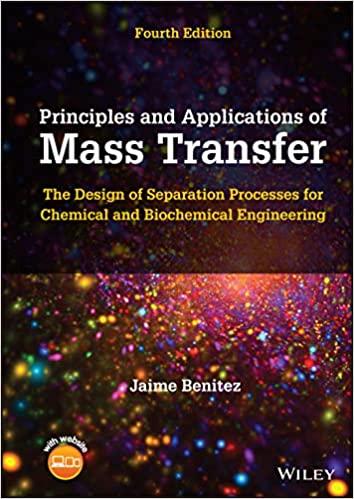In the benzene adsorber of Example 9.7, the flow rate is increased to (0.25 mathrm{~m}^{3} / mathrm{s}).
Question:
In the benzene adsorber of Example 9.7, the flow rate is increased to \(0.25 \mathrm{~m}^{3} / \mathrm{s}\). Calculate the breakthrough time and the fraction of the bed adsorption capacity that has been used at breakthrough. At the increased flow rate, the new value of \(K_{c} a=10.5 \mathrm{~s}^{-1}\).
Data From Example 9.7:-
Repeat the calculations of Example 9.6, but for a Langmuir isotherm with parameters qm = 0.2 kg benzene/kg gel, and K = 51.72 m3 gas/kg gel. Notice that this isotherm gives the same value of q*F = 0.12 kg benzene/kg gel as the linear isotherm of Example 9.6. Assume that all of the other values given in the previous example apply.
Data From Example 9.6:-
Air at 294 K and 1 atm enters a fixed-bed adsorber at a flow rate of 0.146 m3/s with a benzene vapor concentration of 29 g/m3. The cylindrical adsorber is 0.61 m inside diameter and is packed to a height of 1.83 m with 331 kg of silica gel particles having an effective diameter of 2.6 mm and an external porosity of 50%. The adsorption isotherm for benzene has been determined experimentally and found to be linear over the concentration range of interest, given by q = κc, where q is in kg benzene/
kg gel, c is in kg benzene/m3 of gas, and κ = 4.127 m3 of gas/kg of gel. It has been estimated that the overall volumetric mass-transfer coefficient for the conditions prevailing in the bed is Kca = 8.79 s–1. Assuming isothermal and isobaric operation,
calculate
(a) The breakthrough curve.
(b) The breakthrough time, tb, when the concentration in the exiting air is 5% of the inlet concentration.
(c) The fraction of the bed adsorption capacity that has been used at the breakthrough time.
(d) The width of the MTZ (defined here for 0.05 ≤ c/cF ≤ 0.95).
Step by Step Answer:






